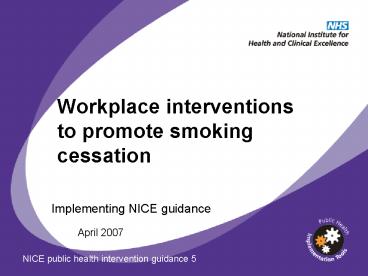Workplace interventions to promote smoking cessation - PowerPoint PPT Presentation
1 / 18
Title:
Workplace interventions to promote smoking cessation
Description:
... secondhand smoke (passive smoking) can affect the health of non-smokers ... A non-smoking working environment encourages people to quit ... – PowerPoint PPT presentation
Number of Views:387
Avg rating:3.0/5.0
Title: Workplace interventions to promote smoking cessation
1
Workplace interventions to promote smoking
cessation
Implementing NICE guidance
April 2007
NICE public health intervention guidance 5
2
Changing practice
- This guidance is for employers and NHS and
non-NHS professionals who have a role in
supporting smokers to give up - NICE public health guidance is based on the best
available evidence - The Department of Health asks NHS organisations
to work towards implementing public health
guidance - NHS compliance with developmental standards will
be monitored by the Healthcare Commission
3
What this presentation covers
- Why implement this guidance?
- Smokefree legislation
- Proven interventions
- Recommendations
- The business case
- Further information and support
4
Why implement this guidance?
- Smoking is the main cause of preventable illness
and premature death in England - Smoking causes a wide range of diseases and
conditions - Breathing secondhand smoke (passive smoking) can
affect the health of non-smokers - Smoking is estimated to cost the NHS in England
up to 1.5 billion a year
5
Why implement this guidance?
- From 1 July all employers in England will be
required by law to provide smokefree workplaces - It will be an offence to smoke or knowingly
permit smoking in smokefree workplaces and in
vehicles used for business - Failure to comply with the law will be an
offence
6
Benefits for employers
- Reduced sicknessabsence
- Increased productivity
- Improved employee health
- Increased compliance with smokefree legislation
7
Effective interventions
- Nicotine replacement therapy (NRT) and bupropion
- Individual behavioural counselling
- Group behaviour therapy programmes
- Self-help materials
- Brief advice
- Telephone counselling and quitlines
8
Effective interventions
- Pharmacotherapies NRT and bupropion
- Individual behavioural counselling with a trained
smoking cessation counsellor - Group behaviour therapy at least two group
meetings offering information and support plus a
behavioural intervention
9
Effective interventions
- Brief interventions opportunistic advice and
support offered in 5-10 minutes - Self-help materials
- Telephone counselling and quitlines
10
Recommendations
- The guidance is for
- employers
- employees and their representatives
- stop smoking services
- strategic health authorities and primary care
trusts
11
What should employers do?
- Make information on local stop smoking support
widely available - Offer to help employees who smoke to quit. Be
responsive to individual needs and preferences - Where possible, provide on-site stop smoking
support - Work with staff and their representatives to
develop a smoking cessation policy
12
What can employees do?
- Contact local stop smoking services for
information, advice and support - Encourage employers to provide advice, guidance
and support to help employees who want to stop
smoking
13
What should stop smoking services do?
- Ensure staff receive training that complies with
the Standard for training in smoking cessation
treatments - Offer employees one or more of the interventions
identified to be effective - Tailor services to employees needs and
preferences - Offer locations and schedules to suit the
individual
14
What should NHS Stop Smoking Services managers
do?
- Where feasible, offer support on the employers
premises - Prioritise small and medium-sized enterprises
(SMEs) where demand exceeds resources available - Target enterprises where a high proportion of
employees are - - on low pay
- - from a disadvantaged background
- - heavy smokers
15
What should SHAs and PCTs do?
- Ensure that NHS Stop Smoking Services have the
resources to respond to fluctuations in demand
16
The business case
- 72 of smokers want to quit
- A non-smoking working environment encourages
people to quit - Loss of productivity of 33 hours per year per
smoker - Use the NICE business case and other costing
tools to help identify costs and savings
17
Access the guidance online
- You can download the following documents from
www.nice.org.uk/PHI005 - A quick reference guide for professionals and the
public - The guidance, which includes all the
recommendations, details of how they were
developed and evidence statements
18
Access tools online
- For employers
- Business case costs and savings related to
smoking cessation activities - Information sheet on the benefits of implementing
NICE guidance - For the NHS
- Audit criteria
- Implementation advice
- Available from www.nice.org.uk/PHI005































